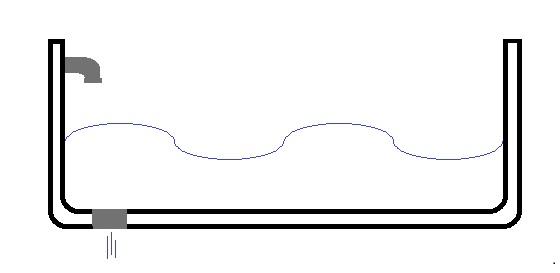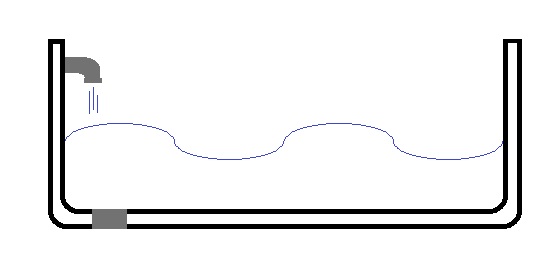In all of my years of work in the field, there are few ideas I discuss with my clients as often as “the bathtub.” Many of my peers use similar concepts in their work. Here’s how it goes.
In terms of one’s emotional energy, i.e., our capacity to get things done and feel good, our brains are a little like a bathtub. Like the one below:

The concept, like my drawing above, isn’t too complicated. There is a spout where the water (or energy) comes in, a drain where it goes out, and the tub where the water/energy is contained.
Every time we do something that takes mental energy, our supply goes down. That energy vanishes down the drain. What takes energy is different for everyone, but most people are negatively impacted by experiences that are demanding, such as shoveling snow, working under a deadline, having an argument with someone they care about, etc. It depends on the person and the activity, but some experiences and activities make us feel spent. And that’s energy out of the tub.

On the other hand, when something that feels good happens, it’s as if our mental bathtub is being filled from the spout. For some people, eating food they enjoy, having a good time with friends, or generally relaxing are rejuvenating activities. That raises the water level. This not only increases our ability to do activities that require energy, it also means we are better able to focus, better able to consider various options as we think things through, and are better able to remember things. Having a fuller tub also means feeling more comfortable, confident and capable.

The key question is, where is the water level? How much mental energy do we have at any one moment? The fuller our mental bathtub is, the better we feel. The more we can handle. When it is low, we feel uncomfortable. If our mental tub is continuously drained, we become more and more unhappy.

When our tubs are low enough, when our mental energy is near gone, our brains kick into gear and try to get us out of the situation. Unfortunately, this isn’t a fun experience. Different brains react differently to being in low energy situations, but there are three common ways for brains to react when we are spent.
Some people’s brains internalize; this means that they tend to experience negative thoughts about themselves or others when they are low. They may have worries that bubble up from their unconsciousness. Their mind may fixate on different ideas. They may feed depressed and/or tired. The way internalizing brains responds to being drained is through negative thoughts and feelings manifest.
When other people are emotionally exhausted, they experience physical symptoms. Their brains somatize the distress. They may have headaches or backaches or stomachaches. They may feel pain in their joints. If they go to a doctor, the doctor may not be able to find anything medically wrong with them. The pain they feel is due to how their brain is processing their stress.
Another group of people may externalize, or act out, on people or things around them when they are overwhelmed. They may yell at people or pets, throw objects, get into fights, etc. The way their brain deals with stressful mental energy is to focus and act on the nearby environment.
Most people do not experience all three types of distress when they are low on energy; although many people may experience two, such as internalizing and somatising symptoms. Psychologists and neurologists have theories about why different people react differently to stressful situations. The major theories tend to focus on genetics and history. If a person had a parent who tended to worry when they were pushed beyond comfort, there is an increased chance that the child will react the same way.
The bathtub metaphor itself is similar to the action described in the books How Full is Your Bucket and How Full is Your Bucket? For Kids, by Tim Rath.
There is no “right” or “wrong” way for brains to react to stress; just as there is no “right” eye color or “right” height. There are pros and cons to each response type. As a psychologist, I often notice that symptoms clients report such as anger, irritation, headaches, depressed feelings, etc. show up when they are emotionally exhausted. Metaphorically, in order to deal our brain’s reactions to stress, one needs to find ways to either close the drain or increase the flow from the spout as much as possible. Learn ways to work with our brain’s way of responding to stress so the responses are more manageable. More about this will be discussed in future posts.
Blog Disclaimer:
This site is for information only. It is not therapy. This blog is only for informational and educational purposes and should not be considered therapy or any form of treatment. We are not able to respond to specific questions or comments about personal situations, appropriate diagnosis or treatment, or otherwise provide any clinical opinions. If you think you need immediate assistance, call your local emergency number or the mental health crisis hotline listed in your local phone book. Use of this blog establishes your consent to the provisions of this disclaimer.
